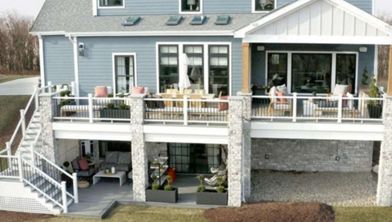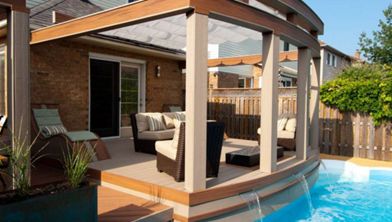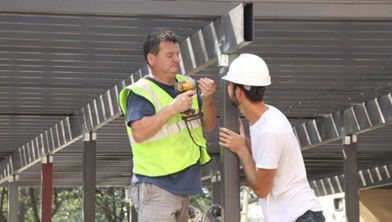Five Ways Trex® Outdecks PVC
While many outdoor enthusiasts love the look of wood, more and more people are turning to wood-alternative decking materials like high-performance composite and PVC. The reason is clear: wood-alternative decks last longer and need less maintenance than a rot-, warp- and splinter-prone wood deck. But when it comes to PVC vs. composite decking, composite trumps PVC in performance, appearance and more. Here are five ways Trex composite deck board beat PVC boards:
Trex is more resistant to the elements—natural or not
When you’re building a deck, you want something that will withstand years of sun, snow and big family gatherings. High-performance composite boards hold strong against natural elements; they resist fading from the sun and won’t get mouldy after a rainstorm or give you splinters. Compared to Trex, PVC shrinks and expands more between seasons. Plus, it fades and can become discoloured from suntan lotion and furnishings like rubber grill mats, outdoor rugs or even the rubber tips on your patio furniture. In fact, PVC is less impact-resistant and therefore more susceptible to scratches, dents and dings from moving your furniture around the deck. Your décor has no effect on Trex, which maintains its rich colour and shape no matter what you put on it.
PVC can’t compete with Trex’s sophisticated colours and grain patterns
While both materials can withstand a storm, only Trex has the long-lasting beauty you want in an outdoor space. Unlike PVC, Trex composite decking has a matte finish that resembles real wood, not the slick look of plastic. In fact, our boards come in a wide spectrum of authentic wood-grain patterns and nature-inspired colours including tropical shades and classic earth tones. These rich colours are designed to complement your home, boosting curb appeal and property value. Compare that to PVC decking which, though improved since the first-generation boards, still has a glossy, plastic-like appearance.
PVC gets chalky; Trex never does
Over time, the vinyl in PVC decking can start to oxidise, leaving you with a deck that looks white and chalky. This effect is particularly noticeable with darker deck colours like deep browns and russet tones. Trex high-performance composite never gets chalky. Not even decades later.
Trex is more affordable than PVC
Since PVC does not contain any post-consumer recycled materials, it’s more expensive to produce (and not nearly as environmentally friendly). In fact, the price of PVC tends to fluctuate with the price of oil. Plus, Trex's easy care can save you hundreds of dollars on long-term maintenance costs compared to other decking materials.
Trex is a far greener choice than
PVC In sharp contrast to PVC, Trex high-performance composite decking contains 95% recycled materials, making Trex one of the largest plastic recyclers in the U.S. The organic material in Trex boards is recycled and reclaimed wood; the polyethylene is principally recycled shrink wrap and grocery bags—all of which would otherwise end up in a landfill. After they're formed, all Trex boards are finished with a proprietary high-performance shell that resists fading, staining, scratching and mould—and is backed by a 25-year fade and stain warranty—which far outweighs PVC's long-term durability.
Only Trex high-performance composite offers you the full package: exceptional environmental responsibility, beautiful aesthetics and top-notch performance. Plus, our decks work beautifully with the rest of our outdoor living offerings including railing, lighting, furniture, pergolas, storage and more. And with a smaller price tag than PVC, Trex makes it easier to kick back and relax on a low-maintenance, eco-friendly deck that will continue to look good for decades.
This content was partially or fully generated by AI and has been reviewed by our team to ensure accuracy and relevance.




































